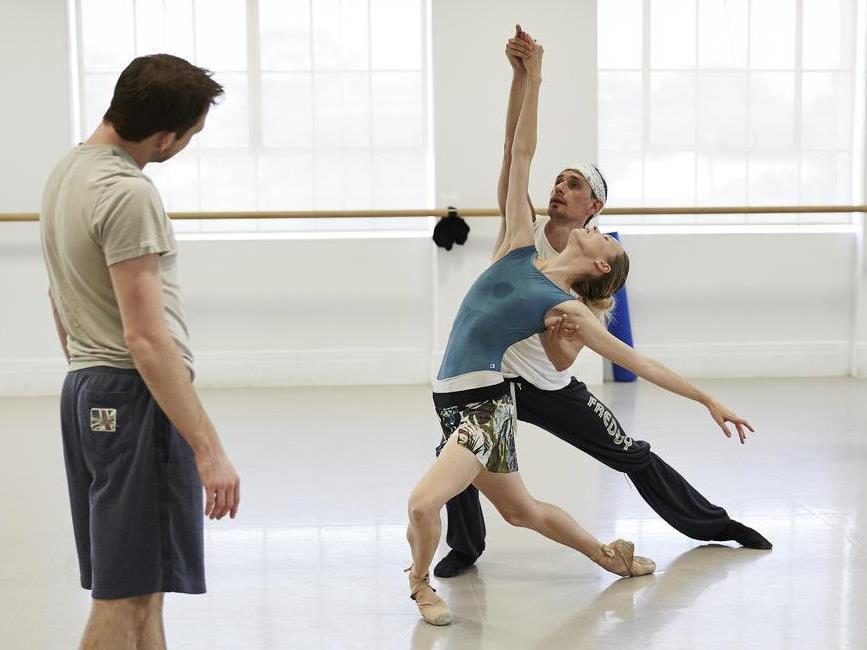Craig Davidson, Brooke Widdison Jacobs and Christopher Hill rehearsing with the WA Ballet. Photo: Sergey Pevnev
Whether online or in person, open rehearsals are becoming a regular event for professional dance companies in Australia and overseas. Where, previously, open rehearsals were reserved for company donors and, in some cases, student groups, the past decade and a half have seen open rehearsals opened to the general public as a strategy for audience development and education.
The findings of an audience reception study, a PhD project undertaken at Queensland University of Technology, highlights that non-expert audiences, when invited into the studio as rehearsal spectators, value rehearsal experiences that feel authentic. In 2013, the study trialled a new open rehearsal model with Sydney Dance Company and The Australian Ballet. Non-expert adult audience members were invited into the studio as spectators, to experience regular company rehearsals during the development of new dance works.
What is an open rehearsal?
The term ‘open rehearsal’ is used as a catch-all phrase as, in practice, an open rehearsal can take many forms. Dance companies are live-streaming rehearsals on social media; opening the theatre door for dress rehearsals and onstage demonstrations; and inviting the public into the dance studio for work-in-progress showings, demonstrations, and genuine rehearsals in some cases. While each of these approaches are distinctive models with great variance in venue, content and the way in which spectators participate, they are all referred to as ‘open rehearsals’.
Perhaps, the greatest appeal of an open rehearsal is to glimpse behind-the-scenes: to uncover the ‘mystery’ of dance-making and the daily life of professional dancers. While all of the open rehearsal models listed above provide insight into creative and/or rehearsal processes, most approaches tend to demonstrate rehearsal to some extent. In other words, ‘open rehearsal’ does not generally translate into a rehearsal that is opened and, instead, it becomes a new type of performance that is based on rehearsals. Examining the spectator experience of a more authentic open rehearsal was the aim of this study.
The effect of authenticity
It is important to acknowledge the absolute impossibility of a spectator to observe a truly authentic rehearsal from within the dance studio. The presence of this person – their gaze, and verbal or physical inter/actions – inherently contributes, to some degree, to a relational dynamic that is different to regular closed rehearsals. However, designing open rehearsals to be as authentic as possible – where the artists make genuine progress in the creation of dance work – can be considered more authentic than other approaches.
For example, a demonstrated rehearsal on stage typically involves an expert (choreographer, rehearsal director, or artistic director) leading the demonstration and providing commentary directed to spectators. Dancers are invited to demonstrate a sequence, are provided feedback from the expert, and demonstrate the sequence again. Throughout, the expert explains the process to the spectators and, in doing so, the relationship between stage and spectators becomes similar to a teacher-student interaction where the expert educates the spectator.
In contrast, where spectators are invited into more authentic rehearsals, a different relationship exists: spectators become “part of the wallpaper”. In this mode of open rehearsal, a choreographer and dancers continue their work, most likely in a dance studio space, regardless of the observers. Instead of being taught about rehearsals, spectators are invited to experience it. In this approach, spectators see, up close, dancers sweat, struggle, laugh, problem-solve, repetition, repetition, and genuine progress in the dance-making process. As one of the study’s spectator participants, an audience member of The Australian Ballet, explained,
And I don’t know if you would automatically think that, if you go to just any performance, whether it would occur to you just how intense, and how many hours and hours and hours [it takes to create a dance], because we sat there for one hour to see that tiny thing [section of choreography], and it wasn’t even properly polished or perfected or finished. So I think you gain a huge perspective seeing that. (Female, 40s, Home Duties)
This deeper understanding of the dancer’s labour significantly shifted perceptions about the amount of work that goes into creating performance. From seeing these processes in action, the final performance became a more impressive and valuable achievement in the eyes of the rehearsal spectators. Their ability to appreciate performance increased through acquiring knowledge about rehearsals through experiencing these processes for real.
A more authentic rehearsal offers spectators a different way to tap into and understand the creative and rehearsal processes. All of the study’s spectator participants enjoyed the more authentic open rehearsal experience. Some felt that this experience detracted from their subsequent experience as audience members of the performance. For them, accessing the more technical side of a dance work distracted them from thematic elements during performance. For most, however, the open rehearsal complimented their experience of the subsequent performance. Perhaps, this point is best explained by one of the spectator participants:
I really enjoyed seeing the rehearsal, but it didn’t in the slightest degree detract from the performance tonight for me. If anything it assisted me to appreciate it more, that I’d seen those real people in their rehearsal gear learning that, and to see the polished performance, it meant more to me having seen the rehearsal. (Female, 50s, Registered Nurse)





